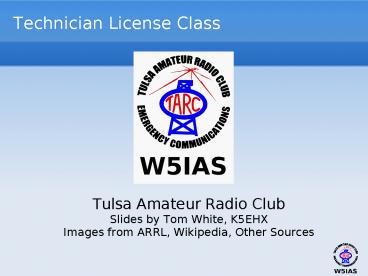Technician License Class - PowerPoint PPT Presentation
1 / 16
Title:
Technician License Class
Description:
Stop using your radio equipment and move to another room until the ... Lightning and Ham Radio. http://www.eng.toyo.ac.jp/~s-katoh/english/lightning2.html ... – PowerPoint PPT presentation
Number of Views:40
Avg rating:3.0/5.0
Title: Technician License Class
1
Technician License Class
- Tulsa Amateur Radio Club
- Slides by Tom White, K5EHX
- Images from ARRL, Wikipedia, Other Sources
2
Chapter 7
- Radio Safety
3
Electrical Hazards
- A commonly accepted value for the lowest voltage
that can cause a dangerous electric shock is 30
volts. - The lowest amount of electrical current flowing
through the human body that is likely to cause
death is 100 milliamperes.
4
AC Wiring
- The green wire in a three-wire electrical plug is
connected to ground. - To guard against electrical shock at your
station - Always use 3-wire cords and plugs for all AC
powered equipment. - Connect all AC powered station equipment to a
common ground. - Use a ground-fault interrupter at each electrical
outlet.
5
Lightning
- If lightning storm is expected
- Disconnect the antenna cables from your station
and move them away from your radio equipment - Unplug all power cords from AC outlets
- Stop using your radio equipment and move to
another room until the storm passes - Lightning can destroy your radio.
- The most important danger with lightning is fire!
6
Lightning and Ham Radio
http//www.eng.toyo.ac.jp/s-katoh/english/lightni
ng2.html
7
Don't let this happen to you!
http//www.astrosurf.com/lombry/qsl-lightning-prot
ection.htm
8
Power Supplies
- You might receive an electric shock from stored
charge in the large capacitors of a power supply.
9
Radio Frequency Energy and the Human Body
- There are two types of RF energy that can damage
the human body - Ionizing - can cause cancer
- Non-ionizing - heats body tissue
- If the combination of signal strength and
frequency cause excessive power to be absorbed,
radio waves can cause damage to the body.
10
Controlling Radiation Exposure
- The level of RF exposure of people near an
amateur transmitter is affected by - Frequency and power level of the RF field
- Distance from the antenna to a person
- Radiation pattern of the antenna
- These factors are how you control RF radiation
exposure. - The human body absorbs more RF energy at some
frequencies than others.
11
Safety Levels
- You may safely use 50 watts PEP at frequencies
above 30Mhz. - If you use more than this, you must perform an RF
exposure evaluation. - To perform an evaluation, use one of the
following - Calculation based on FCC OET Bulletin 65
- Calculation based on computer modeling
- Measurement of field strength using calibrated
equipment
12
Safety Evaluation
- Milliwatts per square centimeter is used to
measure RF radiation exposure. This can be
calculated or looked up in a table. - The duty cycle is factored in to RF radiation
exposure levels because takes into account the
amount of time the transmitter is operating. - Whenever an item of equipment is changed, you can
make sure your station stays in compliance with
RF safety regulations by re-evaluating the
station.
13
Tower Safety - Working on the Tower
- You should always wear a hard hat and safety
glasses if you are on the ground helping someone
work on an antenna tower to protect your head and
eyes in case something accidentally falls from
the tower. - Always put on your safety belt and safety glasses
before climbing an antenna tower. - Before you climbing a tower
- Arrange for a helper or observer
- Inspect the tower for damage or loose hardware
- Make sure there are no electrical storms nearby
14
Tower Safety - Placement
- Always consider the maximum allowed height when
erecting an antenna near an airport. This may be
less than the usual 200 feet. - The most important safety precautions to observe
when putting up an antenna tower - Look for and stay clear of any overhead
electrical wires. - Position the antenna far enough away so that if
the antenna falls unexpectedly, no part of it can
come closer than 10 feet to the power wires. - Make sure people cannot accidentally come into
contact with the antenna.
15
More Tower Safety
- The guy wires for an antenna tower should always
be installed in accordance with the tower
manufacturer's instructions. - A crank-up tower should never be climbed unless
it is in the fully lowered position - Stainless steel is commonly used on antennas
because the parts are much less likely to
corrode. - Separate 8 foot long ground rods for each tower
leg, bonded to the tower and each other are
considered to be an adequate ground system for a
tower.
16
Chapter 7
- The End

